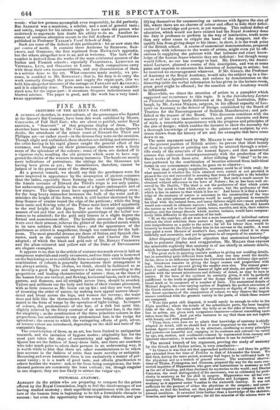FINE ARTS.
SKETCHES OF THE QUEEN'S BAL COSTUME.
A NUMBER of sketches, in 'water colours, of the personages who figured at the Queen's Bal Costume, have been this week exhibited by Messrs. COL.NAGHL of Pall Mall East ; who are about to publish, under Royal sanction, a "Souvenir" of that gorgeous display of dress. The sketches have been made by Mr. COKE SMYTH, to whom, at the Queen's desire, the attendants of the mimic court of Edward the Third and Philippa sat—or rather stood—in the dresses they wore on the occasion. Though slight and unfinished, these sketches are striking and attractive ; the artist having in his rapid glance caught the general effect of the costumes, and brought out their picturesque character with a lively sense of the splendour of the colours: some of them are dashed off in a vigorous style, recalling the old pictures which seem to have sug- gested the choice of the wearers in many instances. The heads are mostly mere indications of portraiture, the sittings for the likenesses not having been given as yet ; the resemblances, therefore, cannot be judged of in the present state of the drawings. As a general remark, we should say that the gentlemen were far more improved in appearance by the assumption of ancient costumes than the ladies, especially those forming the court of Queen Philippa: the female costume of Edward the Third's reign is not only quaint, but unbecoming, particularly in the case of a figure embonpoint and of low stature. The Queen must have appeared to disadvantage even ; for the long heavy stomacher increases the bulk of the waist and di- minishes the height of the form, which is still further shortened by the deep flounce of ermine round the edge of the petticoat ; while the long loose tunic and flowing robe of the Prince must have added apparently to the real height of his figure. Nor are the violent opposition of masses of red and blue and the heraldic quarterings of the ladies' cos- tumes to be admired ; for the gold only lessens in a slight degree the formal and monotonous effect. The heraldic surcoats of the knights, worn over their armour, relieves the glitter of the polished metal, which in its turn subdues their violent hues ; and the appearance of the gentlemen so attired is magnificent, though too cumbrous for the ball- room. The most graceful dresses are those of Italian and Spanish cha- racter, such as the courtiers of Elizabeth and Charles the First adopted ; of which the black and gold suit of Mr. RIDLEY COLBORNE and the plum-coloured and yellow suit of the Duke of DEVONSHIRE are elegant examples. It appears to us, that in the article of costume too much stress is laid on sumptuous materials and costly ornaments, and too little care is bestowed on the fashioning so as to exhibit the form to advantage ; while though the combination of colours is generally harmonious their arrangement is not always artistic. The clothes, we think, should be fashioned so as to develop a good figure and improve a bad one, but according to the proportions and leading characteristics of nature : thus, as the lines of the human form are vertical, and flowing, horizontal bands, such as belts, garters, and flounces, and all straight across lines, should be avoided. Tailors and milliners cut the body and limbs of their victims piecemeal, with as little remorse as Mr. GOOD cut up his ; and they are very fond of reversing the order of nature, by making men appear narrow-shoul- dered and broad across the hips, and women the -reverse; the waist rises and falls like the thermometer, both sexes being alike approxi- mated to the form of wasps by the operation of tight. lacing. In respect of colours, the predominance of one hue, of a rich but quiet tint, slightly relieved by the lively contrast of an accordant hue, is the rule for simplicity ; as the combination of the three primitive colours in due proportions, but subordinate to one predominant hue, is the recipe for splendour ; the extent to which the variegating effects of gold, silver, or intense colour are introduced, depending on the skill and taste of the costumises fancy. The consideration of dress, as an art, has been limited to antiquarian research, and the imitation of bygone modes; originality has for the most part taken the shape of eccentricity and ugliness. Since the Queen has set the fashion of fancy-dress balls, and there are numbers who take much pains to adorn their persons in an unbecoming way, it is worth while to hint that there are other considerations to be taken into account in the fashion of attire than mere novelty or antiquity. Becoming and even handsome dress is not exclusively a matter of per- sonal vanity ; it is a mark of good taste, and affords gratification to others besides the wearer: and, so far from being conspicuous, the best- dressed persons are commonly the least noticed; for, though singular in one respect, they are less likely to attract the vulgar eye.


























 Previous page
Previous page